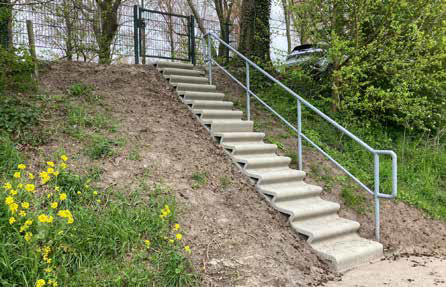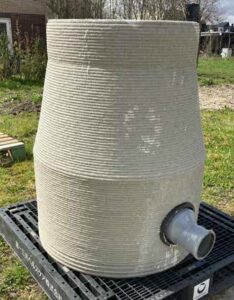3D concrete printing. A relatively new technique with great potential for the future of construction. “Especially with the climate crisis, the large replacement and renovation task and the labor shortage we are facing,” says Pieter Bakker, 3D printing project leader at Saint-Gobain Weber Beamix.
“We are therefore constantly looking for opportunities to become more sustainable and thus have a positive environmental impact on and in our environment.” According to Pieter, smarter construction, including through parametric design, is the solution. “We also apply that within our 3D concrete printing technology.”
Three major pillars
At Saint-Gobain Weber Beamix, the entire development of 3D concrete printing rests on three major pillars: sustainability, automation of construction (with process optimization as a goal) and freedom of form. “In terms of sustainability, we are looking beyond making concrete more eco-friendly. With 3D concrete printing, we have a technique that allows us to use even less material: less concrete, no reinforcement, no formwork. And because the process is largely automated, we can shorten delivery times and respond to the scarcity of skilled workers. In line with this is process optimization, where time and error reduction play a major role.” The third pillar, according to Pieter, is freedom of form. “After all, parametric design is a technical and very important expression of the ease of form freedom, but also the ability to generate ‘more exotic’ shapes plays an important role in this.”
Slope stairs
“A slope stairs, perhaps not the sexiest structure, very clearly demonstrates all the advantages of parametric design, immediately bringing out all the benefits of 3D concrete printing,” says Pieter. “Based on the relevant dimensions, we can design a talus staircase without drawing or calculation, which can be printed the next day and delivered within three weeks.”
The slope stairs is one of the products that Saint-Gobain Weber Beamix is fully marketing within concrete printing. “We are past the pioneering phase, have already realized about 50 stairs in the Netherlands and within the rest of Europe and have now received approval from ProRail, Rijkswaterstaat and several municipalities.”

Without drawing or calculation, we can design a slope stairs, which can be printed the next day and delivered within three weeks.Without drawing or calculation, we can design a talus staircase, which can be printed the next day and delivered within three weeks.
Most sustainable bicycle bridge
A lot more complicated than slope stairs or other fairly standard concrete products such as sewer manholes, are the 3D printed bicycle bridges rolling out of Weber Beamix’s print factory in Eindhoven. “In collaboration with BAM Infra and Province of Noord-Holland, who have really embraced our innovation, we installed four 3D printed bicycle bridges at the N243 earlier this year.
As a construction team, we went through all phases, from sketch to execution, approaching the project with the same three pillars: how can we do this sustainably, fully automated and with as little material as possible, and of course in the context of freedom of form.” This involves four bridges with different arches and dimensions, all realized from the same parametric model. It shows that within certain parameters, a lot really is possible.
Sustainable and digital innovation together
It may be obvious: 3D concrete printing fits a sustainable future. “We have already taken many steps but we are not there yet,” says Pieter. “Governments and industry will have to continue to innovate together to overcome the climate crisis. I therefore invite them to explore and take that step with us.”
This article was written for the Dutch trade magazine GWWTotaal. Click here to read the full article (in Dutch).

Naast taludtrappen en fietsbruggen ontwikkelt Saint-Gobain Weber Beamix ook andere vrij standaard betonproducten zoals rioolputten.
Curious about the possibilities?
Download our brochure of unique objects
in the public space
Do you want to visit one of our 3D printing projects?


